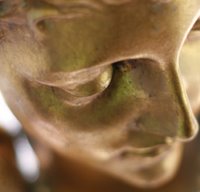Eye Candy for Your Website
An article entitled "When Marketers See Double" appeared in the Wall Street Journal the other day regarding the use of stock photography by major corporations in advertising spreads, on web pages and in other marketing materials.
It seems that in order to maximize their bottom line, these banks, retailers and the like are purchasing stock photos for as little as $1 each rather than paying for costly photo shoots. While by and large these photos cannot be used in whole or in part in a company's logo, for example, they do serve as "eye candy" intended to further the attractiveness of a product and enhance the professional image of the company.
There's no reason why we as aspiring novelists cannot avail ourselves of the same resources. Indeed, the photo used here for my profile and in my header was purchased for $1 from iStockphoto.com (please see website for terms and conditions). I have a file full of others as well which I intend to use once I launch my website www.rebeccadecourcy.com.
Many of us maintain our own websites and still more of us our own blogs. These constitute our personally-defined, "official" presence on the web, and as such they should serve to convey the impression of a writer who is not only creative, but also professional and organized.
Most editors, I would wager, much prefer working with an author of this type, and should you have the opportunity to refer one to your website, it makes best marketing sense to provide an attractive, exciting virtual environment within which they can come to know both you and your work.
As writers we often rely on our verbal abilities alone to sell us as professional and viable authors. In this increasingly visual age, however, we owe it to ourselves to provide as many effective non-verbal indicators of who we are and how we approach our craft as possible.
To give you an example of how these stock photos might be used on your website, I want you to visualize the cover of the book you are currently working on or completed manuscript you hope to publish. Are there people on it? Is there a specific location involved? The American West? An English country house? A private plane?
Now go to iStockphoto or any other stock photo website and browse the available images. Are there any that capture visually the atmosphere you're trying to evoke, the sub-genre in which you are writing?
Now, purchase and download the photo.
On your website, upload the photo and next to it a "teaser" from your manuscript -- a headline, a promo and an excerpt, for example (taking appropriate precautions, of course). If you have published (even e-published) authors' comments on it, include those as well. Underneath, provide a way you can be contacted.
Now, even though your manuscript has yet to be published, you have provided editors, potential readers and the like with a fully-realized marketing package for your book. You'll have broadened their sensory experience, and hopefully increased the sensory pleasure, of your work. Indeed, if you do it right, you may very well have them begging for more.
I'm curious to know your thoughts on this. I'd also like to hear about the marketing strategies you've adopted for your website. In what specific ways are you making your website work for you?
Libellés : Marketing
